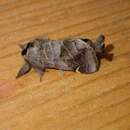Conservation Status
provided by University of Alberta Museums
Uncommon to locally common and widespread; no concerns.
- license
- cc-by-nc
- copyright
- University of Alberta Museums
Cyclicity
provided by University of Alberta Museums
Adults are on the wing from May through early July.
- license
- cc-by-nc
- copyright
- University of Alberta Museums
Distribution
provided by University of Alberta Museums
Across southern Canada, from Quebec to coastal British Columbia, north to Yukon and south to New Jersey and California. In Alberta found mainly in the southern Boreal forest and foothills areas, but also present in the aspen parklands.
- license
- cc-by-nc
- copyright
- University of Alberta Museums
General Description
provided by University of Alberta Museums
A small (2.5-3.0 cm wingspan) dark grey-brown moth, darker and less contrastingly marked than the other Clostera species. It is most easily confused with small, dark specimens of C. apicalis. C. apicalis hase rusty-red or dark orange along the upper section of the postmedian line on the forewing; this is greatly reduced or absent in brucei. Clostera strigosa is larger with pale yellow mottling in the apical area, and C. albosigma has the dark terminal part of the forewing sharply divided from the remainder of the wing. Male antennae bipectinate; sexes similar.
- license
- cc-by-nc
- copyright
- University of Alberta Museums
Habitat
provided by University of Alberta Museums
Mature deciduous and mixedwood forest.
- license
- cc-by-nc
- copyright
- University of Alberta Museums
Life Cycle
provided by University of Alberta Museums
The adults are nocturnal and come to light. The larvae are reported to be both solitary and gregarious leaf-folding defoliators. There is a single brood each year.
- license
- cc-by-nc
- copyright
- University of Alberta Museums
Trophic Strategy
provided by University of Alberta Museums
No specific Alberta data; elsewhere in Canada (including Alberta) Trembling aspen (Populus tremuloides), willow (Salix sp.) and Balsam poplar (Populus balsamifera).
- license
- cc-by-nc
- copyright
- University of Alberta Museums
Clostera brucei
provided by wikipedia EN
- license
- cc-by-sa-3.0
- copyright
- Wikipedia authors and editors
Clostera brucei: Brief Summary
provided by wikipedia EN
Clostera brucei, the Bruce's prominent moth or Bruce's chocolate-tip, is a species of moth in the family Notodontidae (the prominents). It was first described by Henry Edwards in 1885 and it is found in North America.
The MONA or Hodges number for Clostera brucei is 7900.
- license
- cc-by-sa-3.0
- copyright
- Wikipedia authors and editors

